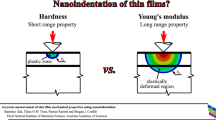Abstract
A simplified model for rapid estimation of maximum subsurface stress was previously reported by the authors. That model was found to predict the upper bound of the maximum von Mises stress in each layer below any surface with good accuracy. In this work, the model is enhanced by quantifying the difference between the predicted upper bound and the maximum stress for a specific rough surface. This is done by evaluating stress predictions for real rough surfaces, sinusoidal surfaces, ideal textured surfaces, and real rough surfaces with imposed computer generated texture. The difference between the predicted upper bound and the surface-specific maximum stress is found to be related to that surface’s roughness. The origin of this relationship is investigated in terms of apparent contact area. The enhanced simplified model provides an efficient means of estimating maximum stress in rough surface contact.







Similar content being viewed by others
References
Martini A., Escoffier B., Wang Q., Liu S.B., Keer L.M., Zhu D., Bujold M. (2006) Tribol. Lett. 23:243
Mihailidis A., Bakolas V., Drivakos N. (2001) Wear 249:546
Kadiric A., Sayles R.S., Zhou X.B., Ioannides E. (2003) J. Tribol. 125:720
Palasantzas G., De Hosson J.T.M. (2000) Acta Mat. 48:3641
Gong Z.Q., Komvopoulos K. (2003) J. Tribol 125:16
Yu M.M.H., Bhushan B. (1996) Wear 200:265
Tao Q., Lee H.P., Lim S.P. (2001) Wear 249:539
Bailey D.M., Sayles R.S. (1991) J. Tribol. 113:729
Lubrecht A.A., Ioannide E. (1991) J Tribol. 113:128
Liu G., Wang Q., Lin C. (1999) Tribol. Trans. 42:581
Gao Y.F., Bower A.F., Kim K.S., Lev L., Cheng Y.T. (2006) Wear 261:145
Jaffar M.J. (1997) Int. J. Mech. Sci. 39:497
Johnson K.L., Greenwood J.A., Higginson J.G. (1985) Int. J. Mech. Sci. 27:383
Etsion I. (2005) J. Tribol. 127:248
Pettersson U., Jacobson S. (2006) Tribol. Int. 39:695
Zou M., Cai L., Wang H. (2006) Tribol. Lett. 21:25
Liu S., Wang Q. (2002) J. Tribol. 124:36
Liu S., Wang Q., Liu G. (2000) Wear 243:101
Acknowledgements
The authors would like to express their sincere gratitude to the Eaton Corporation for providing surface digitization, Wayne W. Chen for assistance with plasticity modeling, and to the US National Science Foundation IGERT Program, Office of Naval Research, and Department of Energy for research support.
Author information
Authors and Affiliations
Corresponding author
Rights and permissions
About this article
Cite this article
Martini, A., Velter, G., Keer, L.M. et al. Enhancement of a simplified model for maximum stress prediction. Tribol Lett 27, 61–67 (2007). https://doi.org/10.1007/s11249-007-9205-1
Received:
Accepted:
Published:
Issue Date:
DOI: https://doi.org/10.1007/s11249-007-9205-1




